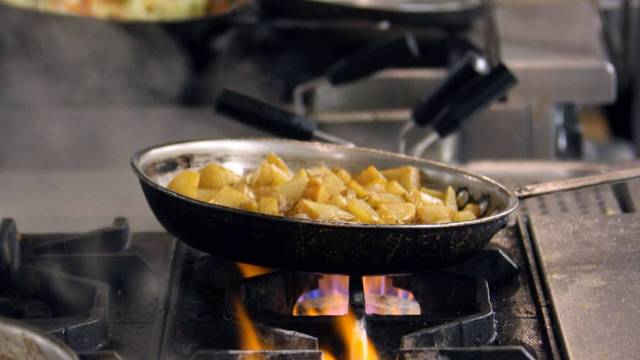Romantic Restaurants Islamabad: Perfect Dining Locations for Pairs
Romantic Restaurants Islamabad: Perfect Dining Locations for Pairs
Blog Article
Savor Authentic Asian Cuisine With a Pan-Asian Twist for a Cooking Adventure
Getting started on a cooking journey with authentic Oriental food, boosted with a Pan-Asian spin, offers a special opportunity to check out the abundant tapestry of flavors that define the region's diverse culinary traditions. As you ponder these enticing recipes, consider the social stories and historical influences that form them, each bite using a story waiting to be uncovered. pan asian dining Islamabad.

Discovering Pan-Asian Flavors
In the world of worldwide gastronomy, Pan-Asian food attracts attention for its amazing variety and the unified interaction of tastes from various Eastern societies. This culinary approach commemorates the unique components and abundant traditions found across the continent, developing a tapestry of tastes that is both intriguing and gratifying. Trick to Pan-Asian cuisine is its capacity to balance different flavors-- pleasant, salted, spicy, and sour-- while highlighting the freshness and quality of each ingredient.
From the umami-rich soy sauce of Japan to the fiery chili peppers of Thailand, Pan-Asian food supplies a comprehensive combination of tastes. These components are usually incorporated in innovative methods, enhancing dishes with layers of complexity. For instance, making use of great smelling natural herbs such as lemongrass and cilantro, common in Vietnamese and Thai food, includes a refreshing brightness to recipes, while the incorporation of coconut milk delivers a creamy, rich texture.
The emphasis on fresh produce and aromatic spices ensures that each meal is not just a banquet for the palate yet additionally for the senses. Pan-Asian cuisine invites restaurants to start a culinary journey, checking out the huge and varied landscapes of Eastern gastronomy with every bite.
Fusion Dishes to Try
While Pan-Asian cuisine is commemorated for its standard flavors, the modern-day culinary landscape is increasingly embracing combination meals that mix these traditional components with impacts from various other regions. This ingenious method not only honors the abundant heritage of Eastern culinary arts but likewise presents unique taste experiences that appeal to modern palates.
An archetype of such a combination dish is the Korean-Mexican taco, where seasoned bulgogi beef is wrapped in a warm tortilla, topped with kimchi and a zesty gochujang-infused salsa. This combination weds the vibrant, tasty tastes of Korea with the dynamic, fresh aspects of Mexican food. Similarly, sushi burritos have gained popularity, joining together the delicate artistry of Japanese sushi with the hearty, hand-held comfort of a burrito, typically featuring blend components like tempura shrimp and avocado with a drizzle of wasabi mayo.
An additional significant dish is Thai curry ramen, which infuses the velvety, fragrant flavors of Thai curry right into the reassuring broth of conventional Japanese ramen, producing an unified blend that entices the detects. These blend dishes prolong past plain uniqueness; they represent a culinary discussion in between cultures, motivating exploration and technology on the planet of Pan-Asian cuisine.
Important Active Ingredients and Seasonings
To truly appreciate Pan-Asian food, one must understand the essential components and seasonings that develop its structure. This diverse cooking design attracts from an abundant tapestry of Eastern practices, employing an unified blend of flavors and appearances.
Aromatic components are crucial, with lemongrass, ginger, and garlic being ubiquitous across numerous Pan-Asian dishes. These ingredients give a great smelling base that improves the intricacy of tastes. Flavors such as star anise, cardamom, and cinnamon present heat and character, resembling impacts from regions like China and India.

Cooking Methods and Tips
Understanding the art of Pan-Asian food calls for familiarity with its unique food preparation strategies, each adding to the dynamic tapestry of tastes this cooking tradition is commemorated for. Central to these methods is the stir-fry, a fast food preparation technique that protects the dietary integrity and brilliant shades of components. Making use of a wok, the stir-fry technique allows for even heat circulation, essential for attaining the characteristic appearance and flavor equilibrium of Pan-Asian recipes.
One more basic method is steaming, especially prevalent in Chinese cuisine. This mild technique maintains the all-natural flavors this and nutrients of components, making it ideal for fish and shellfish and veggies. Dumplings, a precious staple, often take advantage of steaming, leading to soft, succulent textures.
Cooking, additionally important, gives smoky depths to meals such as Korean bulgogi or Japanese yakitori (asian restaurant isb). This technique frequently entails seasoning ingredients, allowing flavors to permeate deeply before food preparation over an open fire or warmer
Lastly, mastering the art of stabilizing flavors-- pleasant, sour, salty, bitter, and umami-- is essential. Properly layering these components can raise a dish from ordinary to phenomenal, supplying a complicated and satisfying cooking experience that symbolizes the essence of Pan-Asian cuisine.
Dining Experiences Worldwide
Around the world, Pan-Asian food uses an unmatched eating experience, celebrated for its abundant tapestry of flavors and vibrant discussions. This culinary sensation has transcended cultural borders, recording the hearts and tastes buds of food fanatics worldwide. In multicultural cities like New York, London, and Sydney, Pan-Asian dining establishments offer as melting pots where culinary practices from Thailand, Japan, China, and beyond assemble, providing diners with an eclectic mix of dishes that highlight the area's variety.
The worldwide allure of Pan-Asian cuisine lies in its capacity to supply both authenticity and development. Cooks masterfully marry standard active ingredients such as lemongrass, soy sauce, and miso with modern strategies, causing recipes that are both acquainted and refreshingly new. This fusion permits diners to embark on a cooking trip that respects heritage while welcoming modernity.
Additionally, eating experiences are boosted via attentively made settings that mirror the values of Pan-Asian aesthetic appeals. From minimal Japanese-inspired insides to vivid Thai-themed rooms, each restaurant uses a distinct setting that complements the cooking offerings. Because of this, patrons are not simply cava restaurant consuming a meal yet partaking in a cultural experience, making Pan-Asian eating an absolutely international phenomenon.
Final Thought
The expedition of Pan-Asian food supplies a profound understanding of the elaborate interaction of flavors and culinary customs throughout Asia. By welcoming fusion meals such as Thai curry ramen and sushi burritos, the cooking journey not just highlights the flexibility of conventional ingredients however likewise showcases innovative modern strategies. This gastronomic journey, enhanced by cooking methods and important flavors, provides an one-of-a-kind opportunity to value the multiculturalism and culinary virtuosity that define Pan-Asian food on a global range.
Getting started on a culinary journey via authentic Oriental food, enhanced with a Pan-Asian spin, provides a check out here special opportunity to explore the abundant tapestry of tastes that define the region's varied culinary customs.In the world of global gastronomy, Pan-Asian food stands out for its amazing variety and the harmonious interaction of flavors from numerous Eastern cultures. Key to Pan-Asian food is its capability to stabilize contrasting flavors-- sweet, salty, spicy, and sour-- while highlighting the quality and high quality of each active ingredient.

Report this page